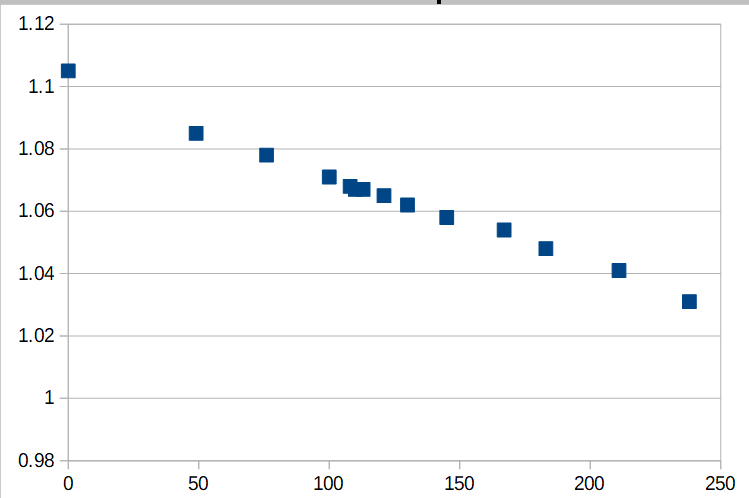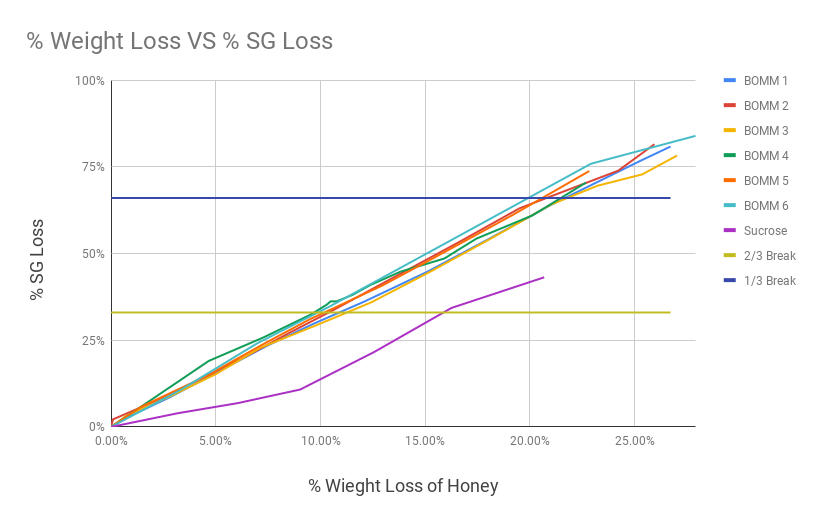After a bit of a delay I got 3 batches started this last Saturday (3-16) and have some data to report.
I am taking both a weight and a SG reading. I hope to have some graphs soon and will post a link to the google doc once it is ready. All three have ~2.3# of honey and started at an OG of a bit over 1090. All weights below are in grams.
So far the ratio of Δ weight to Δ SG is running between 4.6 and 3.3 with an overall average of 3.7.
BOMM 1
Wt Honey 1074
Wt Total 5305
Day # - Wt g - SG
Day 1 - 5305 - 1094
Day 2 - 5299 - 1092
Day 3 - 5275 - 1086
Day 4 - 5250 - 1079
Day 5 - 5225 - 1072
Day 6
Day 7
BOMM 2
Wt Honey 1102
Wt Total 5400
Day # - Wt g - SG
Day 1 - 5400 - 1092
Day 2 - 5399 - 1090
Day 3 - 5376 - 1085
Day 4 - 5352 - 1079
Day 5 - 5328 - 1073
Day 6
Day 7
BOMM 3
Wt Honey 1080
Wt Total 5384
Day # - Wt g - SG
Day 1 - 5384 - 1092
Day 2 - 5376 - 1089
Day 3 - 5554 - 1084
Day 4 - 5330 - 1078
Day 5 - 5307 - 1071
Day 6
Day 7
Edit:
All additional notes will be published here.
https://docs.google.com/spreadsheets/d/1HO9oETsDfIBzg3mDongO-Axkk5r4g5PK7ZwKrVTFe90/edit?usp=sharing
I am taking both a weight and a SG reading. I hope to have some graphs soon and will post a link to the google doc once it is ready. All three have ~2.3# of honey and started at an OG of a bit over 1090. All weights below are in grams.
So far the ratio of Δ weight to Δ SG is running between 4.6 and 3.3 with an overall average of 3.7.
BOMM 1
Wt Honey 1074
Wt Total 5305
Day # - Wt g - SG
Day 1 - 5305 - 1094
Day 2 - 5299 - 1092
Day 3 - 5275 - 1086
Day 4 - 5250 - 1079
Day 5 - 5225 - 1072
Day 6
Day 7
BOMM 2
Wt Honey 1102
Wt Total 5400
Day # - Wt g - SG
Day 1 - 5400 - 1092
Day 2 - 5399 - 1090
Day 3 - 5376 - 1085
Day 4 - 5352 - 1079
Day 5 - 5328 - 1073
Day 6
Day 7
BOMM 3
Wt Honey 1080
Wt Total 5384
Day # - Wt g - SG
Day 1 - 5384 - 1092
Day 2 - 5376 - 1089
Day 3 - 5554 - 1084
Day 4 - 5330 - 1078
Day 5 - 5307 - 1071
Day 6
Day 7
Edit:
All additional notes will be published here.
https://docs.google.com/spreadsheets/d/1HO9oETsDfIBzg3mDongO-Axkk5r4g5PK7ZwKrVTFe90/edit?usp=sharing
Last edited:




 That said, I hope you find a better formula than me.
That said, I hope you find a better formula than me.
